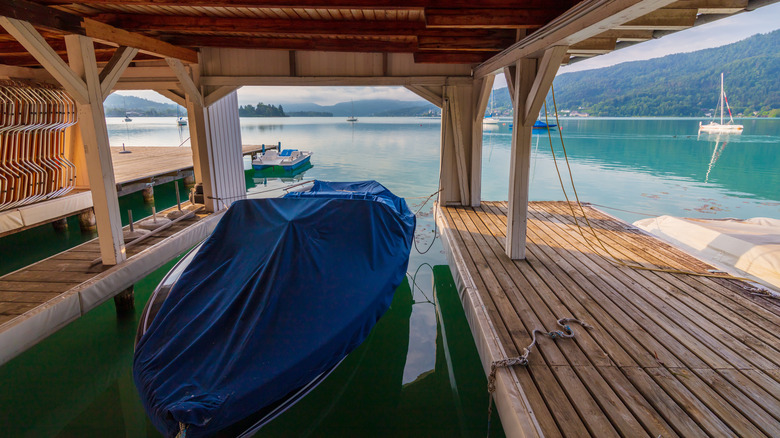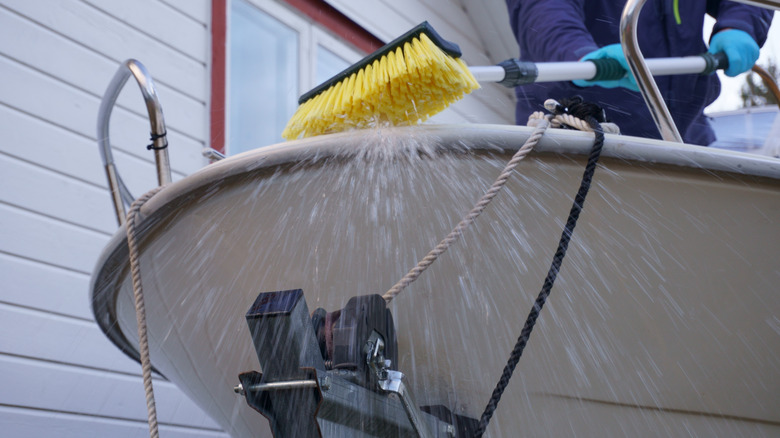Keep Your Boat In Pristine Condition With This Drying Hack
Having owned boats since I was a kid and utilizing a variety of vessels to make a living over the past 30 years, I have come to understand the importance of keeping a boat dry while it is not in use. I have also found out that it isn't always as easy as it seems. However, I have also learned a few simple tricks to keep boats dry while they're sitting idle.
Whether it is being stored long-term or just for a day or so, a boat needs to remain dry to prevent a variety of issues. Mold and mildew can take hold on fiberglass surfaces, as well as carpet, vinyl seats and cushions, and even windshields and grab rails. Additionally, corrosion and rust can set in on any metal parts, including wiring, which can lead to all sorts of malfunctions.
On the surface, the solution seems to simply make sure a boat is dry before it is stored. But, just because it was dry when you covered it or put it in the storage shed doesn't mean it will stay that way. Rain is an obvious way stored boats get wet. Even those with covers pulled tight will see rainwater find a way to seep in. Humidity, though, is perhaps an even greater threat to introduce moisture to your stored boat. Boats that are tarped or covered or in a confined area that doesn't allow for natural airflow are especially susceptible to moisture buildup from humidity and condensation. However, you can keep your boat in pristine condition with this drying hack.
Properly prepare your boat for storage
A boat needs to be properly prepared for storage before it is put up for any length of time, be it 24 hours or two months. That essentially means it needs to be clean and dry. Before beginning the task of washing your boat, it's a good idea to remove the emergency boating equipment, including any lifejackets and PFDs, and set them to the side. Mooring and anchor lines should also be removed, assuming they are not in use. These items are notorious for holding moisture and should be removed from hatches and allowed to air dry –- preferably in the sun –- after each outing and periodically during long-term storage. This also gives you a chance to inspect the condition of your emergency equipment and replace any damaged items.
Next, rinse your boat with freshwater before scrubbing with soapy water and a soft-bristle brush. It's a good idea to use a boat wash with anti-microbial properties. Be sure to clean even vinyl seats and carpeted areas. Then, rinse thoroughly. Dry the hull with a chamois or soft-cloth. Allow the boat to air dry as long as possible before covering or putting in an enclosed storage area. If you have foam or pool noodle-covered rails for tackle storage or safety concerns, be aware the foam will hold moisture longer and needs more dry time. While the boat is drying, you can also squirt a bit of WD-40 on metal parts and wipe them down. This will help prevent rust and corrosion and drive any remaining moisture from small cracks and crevices.
Use a fan for this boat-drying hack
Once your boat is thoroughly dry, it is ready to be covered or placed in a storage unit — or both. If you plan to use the boat again relatively soon, go ahead and place the dry emergency equipment, life jackets, and lines back in storage hatches. If the boat will be stored for a long period of time, it is probably best to leave these items out on the deck or hanging in the storage unit instead of crammed into a hatch where they will be open to more air.
To that end, ensuring that the air remains moving is the key to preventing mold and mildew from growing on your boat and equipment. According to BoatUS, the air in a boat should be replaced every hour to prevent the growth of mold and mildew. A good way to accomplish this is by placing a fan — or fans, depending on the size of the boat — in the cockpit of the boat. A standard household box fan will work just fine. If the boat is tarped or covered, place the fan under the tarp and leave a small space open between the tarp and boat to ensure an air exchange. Be sure to leave all hatches, consoles, coolers, and doors open so that air circulates in every portion of the boat. In particularly humid environments, it is also helpful to place a few humidity pods or moisture-control packs throughout the boat, especially in areas with less air circulation.


